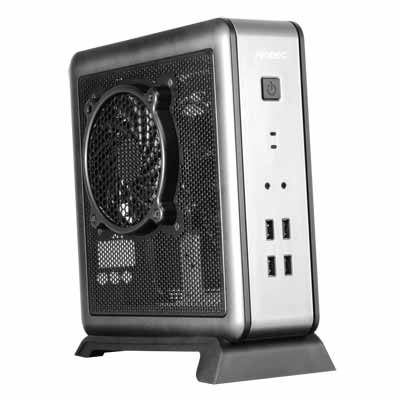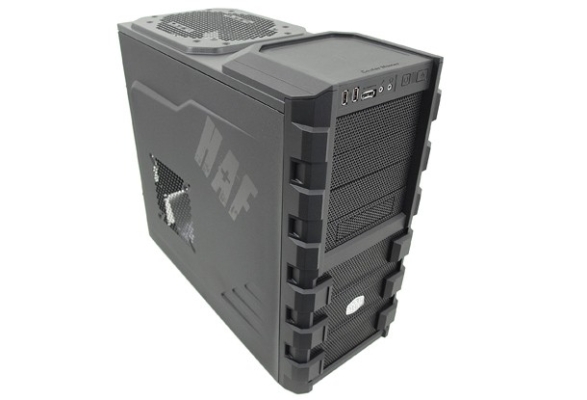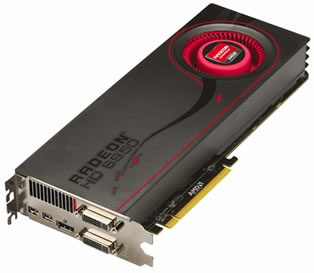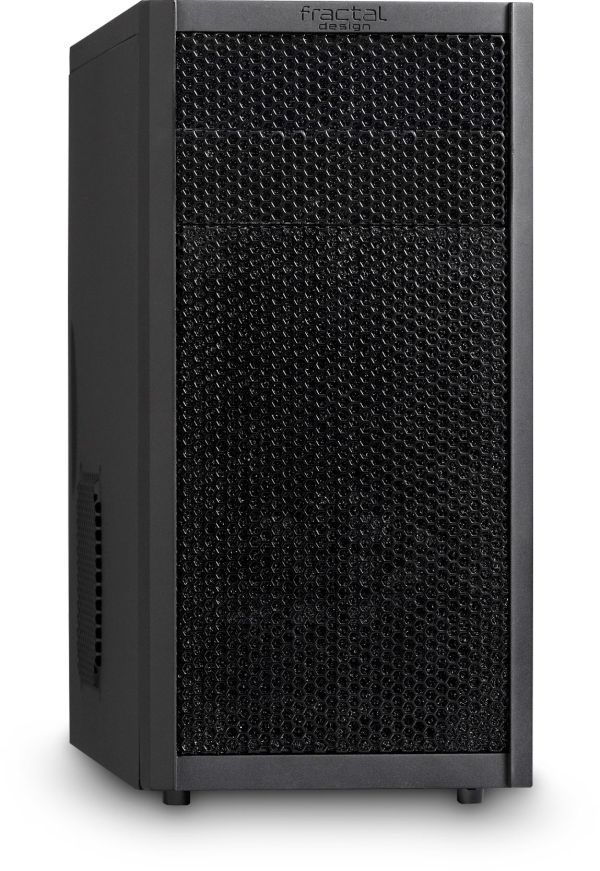Back To School Technology Buyer's Guide
by Zach Throckmorton on August 4, 2011 8:55 PM ESTBuild your own PC
You can usually build a desktop computer for less money than it costs to buy a comparably-specced system from a retailer. The discrepancy generally becomes greater as overall cost and capability go up. Additionally, many college students have access to very low cost Windows 7 licenses. For example, Windows 7 Ultimate costs students here at UW-Madison $64, while at Indiana University it's $20 and at the University of Michigan, $19 (Wolverines can also buy Vista for $9.50—curb your enthusiasm). Be sure to check with your specific college to see if you can get Windows (and other useful software) at a discount before paying retail prices for your OS. Because the cost of the OS varies dramatically from college to college, it is omitted from the following builds.
With that important consideration, let's get to the builds! We present here three configurations: a very tiny but capable mini-ITX system, a relatively small, inexpensive micro-ATX rig, and a more powerful mid-tower. We also suggest upgrades for each computer tailored to different uses.
Intel Mini-ITX System
| Intel Core i3 Sandy Bridge mini-ITX PC | |||||
| Component | Product Name | Cost | |||
| Case + PSU | Antec ISK 100 80W PSU | $85 | |||
| CPU | Intel Core i3-2100T | $135 | |||
| Motherboard | ASUS P8H61-I (Rev. 3.0) | $85 | |||
| Memory | Patriot 4GB (2x2GB) DDR3 SDRAM | $33 | |||
| Hard drive | Samsung Spinpoint MP4 HM320HJ 320GB | $48 | |||
| Total: | $386 | ||||

This mini-ITX system built in an Antec ISK 100 is more than powerful enough to handle web browsing, HD video playback, photo and video editing, many kinds of scientific analysis, and of course, office productivity. It's also sufficiently powerful that you should expect to be able to use it to perform these tasks for your entire four year undergraduate career. Best of all, its tiny case measures less than 9" tall by 9" deep by 4" wide. That's about the size of a hardcover novel (and smaller than an intro biology text!)—saving valuable real estate in a cramped dorm room, for example. Once assembled, it will weigh less than four pounds. It's important to note that the ultra low-profile heatsink that comes with the Core i3-2100T fits inside the ISK 100, but the stock heatsink that comes with the Core i3-2100 does not. Gelid makes a low-profile heatsink that would let you use a Core i3-2100 in the ISK 100 but it is difficult to find. Perhaps its only drawbacks given its size are that it lacks an optical drive and it is not a gaming computer, nor can it be upgraded to become a gaming computer. That said, there is room for two 2.5" hard drives, so you could certainly upgrade it for faster responsivity by adding an SSD or for more storage by adding a more spacious, slower 2.5" mechanical drive.
AMD Micro-ATX System
| AMD Athlon II X3 Micro-ATX PC | ||
| Component | Product Name | Cost |
| Case | Fractal Design Core 1000 | $50 |
| PSU | XIGMATEK ACXTNRP-PC402 400W | $35 |
| CPU | AMD Athlon II X3 445 | $75 |
| Motherboard | Biostar A880G+ | $55 |
| Memory | Patriot 4GB (2x2GB) DDR3 SDRAM | $33 |
| Hard drive | Western Digital WD5000AAKX 500GB | $40 |
| Optical drive | LITE-ON iHAS124-04 | $20 |
| Total: | $298 | |
While the AMD Athlon II X3 445 is slightly less powerful than the Intel Core i3-2100T in the mini-ITX system, it is nevertheless a potent processor up to most tasks, and certainly more than sufficient to provide four years of basic computing. This AMD CPU offers tremendous value—a lot of bang for the buck. Importantly, should you deem more power necessary in a few years, the six core Thuban CPUs will be simple, drop-in upgrades and by then, likely will cost less than $100. That said, the tri-core chip will remain a capable office system processor for four years. For an idea of how it performs, check AnandTech's Bench.
The Fractal Design Core 1000 is one of my favorite newer cases to hit the market. Its low price tag, quality construction, smaller size, and aesthetics are major selling points. At less than 17" deep by 7" wide by 14" tall, it's more compact than many micro-ATX cases, yet large enough to hold many hard drives, a bigger aftermarket CPU heatsink, and/or a larger GPU if you want to upgrade it. I find its thermals are slightly improved by moving the front intake fan to the rear of the case to act as an exhaust.
Biostar's A880G+ is a great value; it's a well-featured budget board that even has an HDMI port, and its integrated Radeon HD 4250 graphics are more than adequate for running Windows' Aero feature and Flash games. Perhaps its only drawback at this price point is its lack of USB 3.0 ports, which will become increasingly useful, though again at this low price, they aren't expected (and a USB 3.0 expansion bracket could be added later if the need arises). Finally, the Xigmatek PC402 400W PSU is relatively well-built for its price tag, and has a quiet 140mm fan.
This system could easily be turned into a respectable gaming rig by adding a discrete video card. Given the thermal limitations of the case at stock, I suggest adding a 120mm fan for better airflow. And given the limitations of the 400W PSU, I wouldn't add a GPU that's more power-hungry than a Radeon HD 6870, and even that would require a molex-PCIe adapter. The Radeon HD 6770 (the rebadged Radeon HD 5770) remains a very strong value for $100 or less after rebate, providing gamers acceptable frame rates or better at resolutions lower than 1080p with medium settings in all but the most demanding games.
Intel Mid-Tower System
| Intel Core i5 Sandy Bridge ATX PC | |||
| Component | Product Name | Cost | Rebate |
| Case | Cooler Master HAF 912 | $75 | -$10 |
| PSU | Antec Earthwatts 430W | $44 | |
| CPU | Intel Core i5-2500K | $220 | |
| CPU heatsink | Cooler Master Hyper 212+ | $30 | |
| Motherboard | Biostar TZ68A+ | $100 | |
| Memory | Patriot 8GB Gamer 2 Series (2x4GB) DDR3 SDRAM | $55 | -$20 |
| Primary storage | OCZ Vertex 2 solid state drive | $100 | |
| Secondary storage | Western Digital 1TB 5400RPM WD10EARS hard drive | $55 | |
| Video card | XFX HD-679X-ZDFC Radeon HD 6790 | $135 | -$15 |
| Optical drive | Samsung SH-222AB | $19 | |
| Total: | $833 | $788 | |

If you have more space than a typical dorm room (or think having a powerful computer is worth being even more cramped than usual in a dorm room), this midtower has all the bases covered. The Cooler Master HAF 912 features excellent thermals (HAF stands for high air flow), integrated mounts for 2.5" SSDs, solid cable management, and it's capacious enough for larger video cards and aftermarket CPU heatsinks. At 20" deep by just over 9" wide by 19" tall and weighing in at 18 pounds, it's probably not going to disappear if you inadvertently leave your room unlocked.
The Intel Core i5-2500K is an extremely potent CPU that will remain a very solid processor for four more years (think of how 2007's Q6600 is still a capable chip). Its performance metrics are available in Bench. The Cooler Master Hyper 212+ is a great value, and should allow you to overclock the CPU to 4GHz with minimal effort, though better chips can hit 4.5GHz and some even approach 5GHz. I've had excellent results from the Biostar motherboard in terms of overclocking, and its low price for a Z68-chipset board with all the bells and whistles makes it a compelling option. Of course, a system like this should have an SSD for overall responsiveness, and the OCZ Vertex 2 is a venerable stalwart at an increasingly low price. The 1TB low RPM hard drive offers plenty of storage, though you could certainly swap it out for a larger, faster (i.e. 7200RPM) hard drive if you'll be installing a lot of games that won't fit on the SSD and will benefit from not being put on a 'green' drive.

Finally, we've opted to recommend a Radeon HD 6790 because of its value, though a GeForce GTX 460 1GB might be worth spending a few dollars more for a bit better performance. If you want to spring for GPUs that will play the latest titles for a year or two longer than these, consider the AMD Radeon HD 6950 and NVIDIA GeForce GTX 560 Ti. These cards trade blows both in terms of performance and are priced at $200 or slightly higher.
While these do it yourself builds cover a range of typical college uses and needs, we recognize that many readers prefer retail, pre-built systems. Therefore a few models are discussed on the next page.











94 Comments
View All Comments
overseer - Friday, August 5, 2011 - link
What I saw was the ASUS F1A75-I Deluxe, however I didn't confirm the stock with the etailer. http://item.taobao.com/item.htm?id=10954053720ASRock has an A75 ITX board around the corner as well. I believe those will be available at major channels in a week or two.
But 65W Llano SKUs... might be due out in Sep. (along with Bulldozer?) Umm this whole year has been about waiting AMD new arrivals.
frozentundra123456 - Friday, August 5, 2011 - link
Great article by the way.I have a question regarding the AMD E-350 APU. The first machine I saw this in was the HP dm1v, and I thought it was great. Thin, light, good battery life, and both better CPU performance and graphics than any atom.
However, I am seeing a lot of 15.6 inch laptops in local retail stores with the E-350.
Does anyone have any experience with this platform? It seems like an ideal fit for a netbook, but underpowered for a full size laptop.
And I also question the abiity of the Llano laptops to play all the games he mentioned at decent settings even at a 1366 x 768 resolution.
Granted, they are way better than intels integrated graphics, but can you really get a decent gaming experience with the titles listed without a discrete card?? (Decent to me would mean over 30 FPS at medium settings at native resolution.)
andymcca - Friday, August 5, 2011 - link
I've only had it for a day, but I just got a low-end Llano laptop (A4-3300M, the cheapest one they have at the moment), and I'm already impressed with it.I realized after playing with my settings that I was on battery power (for an hour, and still ~70% battery after gaming!), so performance may have been scaled down. Even so, I was getting 25-30FPS average in WoW and SC2 on medium. I was not in huge battles or anything, though.
I imagine the more capable models must kick some medium-setting butt. Most of the reviews seem to indicate this, too.
Taft12 - Friday, August 5, 2011 - link
However, I am seeing a lot of 15.6 inch laptops in local retail stores with the E-350.Does anyone have any experience with this platform
It's an idiotic platform. Toshiba, HP et al. are only doing it for the sake of putting a $350 price tag on a full-sized laptop. Most laptop shoppers are looking at the price only and don't know or care about any technical specs.
Chron79 - Saturday, August 6, 2011 - link
I recently purchased an E-350 Lenovo from BB for $300. This is basically a test purchase to see if I want/need anything more once the fall semester begins.It handles internet video fine up to 720p I would say. 1080p YouTube and Netflix streaming HD content can get choppy at times, but those are both luxuries. I loaded Office 2010 and have put Acrobat through its paces with my summer seminar work and everything seems responsive. Also tried WoW, and would call it passable in low-to-medium settings but nothing to write home about. If you plan to game at all on a laptop the E-350s are not for you anyway.
What I love is the overall package and battery life. Fingerprint/face recognition, media card reader, hdmi out, 4 gb RAM and anywhere from 6-8 hours of use depending on your video use. Also the base stays super cool - just a tiny bit of warmth in the upper left quadrant the quiet fan handles. If you are a basic college student who does not game or has a desktop for gaming I really don't see where you would need more than this. To me the next logical step up is $600-700 with BR drives and/or the new A6/A8 cpu/gpu functionality. If you can afford these then more power to you, but for those looking to make ends meet this $300 model is a great deal.
yourwhiteshadow - Friday, August 5, 2011 - link
i made the mistake of buying just a laptop. its not comfortable to do your stuff on a laptop. best bet is to get netbook + desktop. get high productivity in your room, and be able to take notes or do whatever in the class room.honestly though, note taking on the laptop is overrated. i don't remember taking that many notes on my laptop as a science major. my $1200 macbook pro was honestly a big waste of money. should have bought a $500 laptop and upgraded my rig, imagine how far $700 would have went when you already have a case, PSU, fan, etc...
frozentundra123456 - Friday, August 5, 2011 - link
No one mentioned Windows Live Skydrive for cloud storage. You get a really large amount of storage (25 Gb I believe) for free.Is there some reason not to use this, such as lack of security or difficulty transferring files??
I used it to store some photos that I did not care if anyone saw, but I am not sure you can load entire folders at once or if you have to upload one file at a time, which would be impractical.
duploxxx - Friday, August 5, 2011 - link
It's hard to defend any atom based netbook these days, even the Ontario based APU is way better in the lower end netbook area.for the Asus EEE pc 1001P there is a much better solution called 1015B with a c30 apu
http://www.newegg.com/Product/Product.aspx?Item=N8...
its even cheaper....
A series LIano are in the range between 500-700$ its artificial OEM prices that keep these solutions expensive, the cost price of the A series liano is less expensive then the new intel i3-i5 series, yet priced higher.
http://www.newegg.com/Product/ProductList.aspx?Sub...
mtwardochleb - Friday, August 5, 2011 - link
I'm heading up to Cal Poly SLO next month with a gaming desktop and an iPad 2. I used them together for the last few months of high school and quite enjoyed the experience. Being a tech-savvy user I'd like to share some experiences and recommendations.Having a fast computer paired with a 24" monitor seems essential to me for productivity since it enables one to comfortably read a web browser while using Word. It's also fantastic when editing video and watching movies in full HD, or browsing the web without having to minimize chat client windows. I use a SSD for my boot drive and a 2TB green HDD RAID1 array for hardware failure-resistant storage. A backup and image of the SSD are run daily and everything is copied to a 2TB external once a week. I consider this to be a very comfortable level of data redundancy and highly recommend it for anyone who has a lot of data.
The NoteTaker HD app on the iPad is exellent for notes on the go, especially since it lets you annotate PDFs and pictures you take with the iPad cameras. I used this feature to take pictures of handouts in class to consolidate everything in one location. For PDF textbooks I use iBooks and for all other books I find Stanza to work extremely well, especially since it can download books wirelessly off your hard drive when paired with Calibre. There's also a wonderful app called Splashtop HD that gives very good remote desktop functionality over the Internet that's smooth enough for videos or playing Starcraft (albeit clumsily). For EE majors I also found a great app called iCircuit which allows you to design and simulate circuits in real-time.
As for other peripherals, I can say having a more expensive printer is very nice. I have an iP4300 which has automatic duplexing, a very large black ink tank, and a paper cartridge. The cost for text printing is pretty low and the picture printing is superb. Printing 8x10 pictures and other odd sizes also comes out cheaper than having the work done at a lab, which is nice if you enjoy photography. A wireless mouse and keyboard are a must for reducing clutter. If you're a serious musician or just really appreciate music I highly recommend splurging for the Audio Technica ATH-M40fs studiophones. They can be had for around $80 and provide excellent sound quality with great responsiveness to equalization settings (I prefer a bump in bass since I'm used to my Logitech Z-2300 system). Be aware of the 10ft cord and 1/4" professional TRS plug, both useful features in certain situations and annoying in others.
Blaze-Senpai - Friday, August 5, 2011 - link
I don't know about you guys, but I don't mind a slightly bigger laptop that can do everything I need it to do decently, although I can understand people not wanting large computers.I still think its weird people complain about laptops being too heavy, do people notice that much of a difference between 6 and 7 pounds? Just get a backpack that can hold it.
...actually, why aren't bags included? You need a way to carry around all of that stuff, after all :3